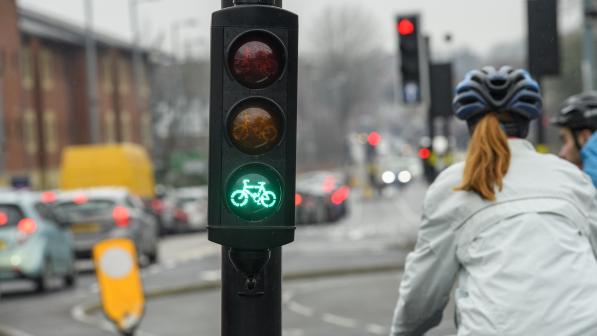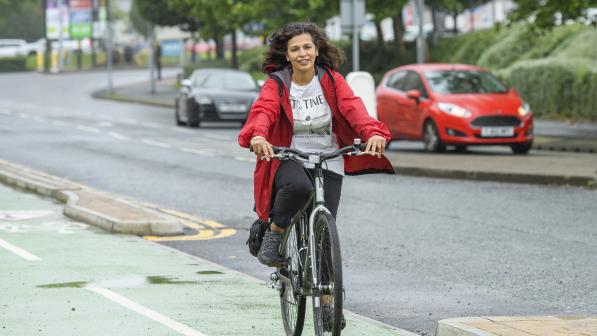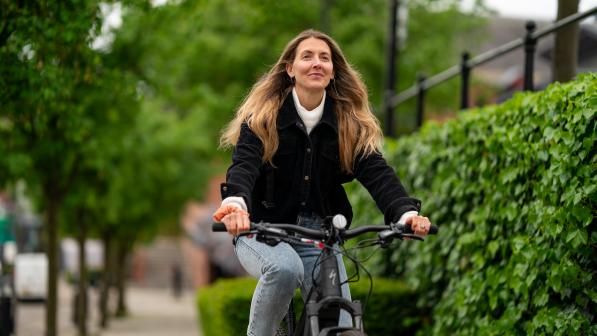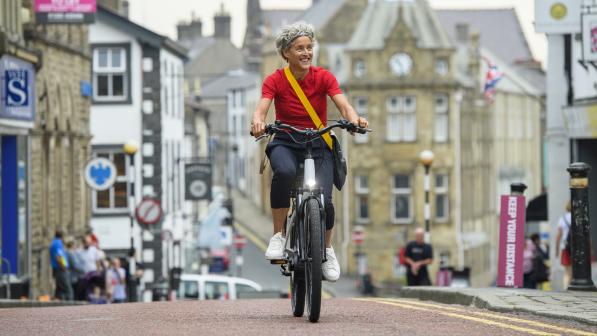My ride. Our right: Charlotte, 40, north London
Supporting Cycling UK’s campaign, 'My ride. Our right’, Charlotte Claydon, 40, started cycling during the pandemic for sheer convenience, as it made the school run and errands much quicker and easier. Despite her confidence, she says it’s not made easy due to a complete lack of suitable cycle paths in her neighbourhood, while her husband has a direct cycle route to work.
Mum and Bike Bus Camden founder Charlotte used to drive the mile and a half to take her kids to school before the pandemic, even though traffic and finding a parking space used to make her anxious. Then, when things reopened after lockdown, she began walking her kids to school but soon started wondering how much quicker it would be to ride a bike.
“It’s just a logical step. If you want your life to be easier, then cycling makes perfect sense, so we got rid of that car. My life has been exponentially easier for having a bike because I can quickly go to seven different shops in quick succession.”
Yet there are no dedicated cycle paths in the area for the types of trips Charlotte makes up and down school streets and to local amenities.
“When my husband cycles to work in the City of London, once he’s three minutes from our front door going the other direction, he’s on separated cycleways all the way to work. It’s crazy to think some of the most vulnerable people are children, and the mothers taking them to school have zero infrastructure.”
Cycle confident
The patchy network of cycle lanes in north London can feel a bit like hopping from one island of safety to another. However, Charlotte partially credits the free one-to-one cycling lessons Camden Council provides to her feeling confident more on her bike these days and wishes this was something that was more widely publicised.
She’s encountered a fair amount of hostility from other road users, and in the early days, that used to really throw her. While she’s never felt much misogyny or been verbally harassed by strangers in the street while on foot, Charlotte has felt an enormous amount of it on her bike.
Charlotte recalls a very bad experience near the beginning of her cycle journey, on her way to take her daughter to a birthday party. There was a series of short sections of road punctuated by traffic lights. A truck continued to speed past her very close between each section, with her stopping in front each time.
The two men in the truck had their windows rolled down and music blaring, so Charlotte smiled and politely asked why they kept doing that. The men screamed obscenities back, swearing and calling her misogynistic names, while her daughter was in the child seat.
“My daughter at the time was about five, I think she was in reception. And it’s one of those things, where you’re mostly just puzzled and then really frightened, it left me really shaky. We’re all sort of used to explaining things to children and I was at a loss for words for how to explain that.”
Understandably, Charlotte was too shaken to cycle back with her daughter from the party, and a couple of helpful friends from the party kindly offered them a lift back.
Charlotte agrees it’s sometimes difficult to know whether aggression is gendered, but acknowledges her husband sometimes gets cut up by inconsiderate drivers, but has never come home saying someone shouted verbal abuse at him, which she says speaks volumes.
Road anonymity
Charlotte suggests that sometimes cars afford drivers a similar anonymity to what online trolls make use of. “There’s something a bit anonymous about being in your car and you get to shout at things and drive off and you’ll never know who it was.”
She sometimes has a camera attached to her bike, which mostly works as a deterrent for verbal abuse. “Funnily enough, if I’ve got the camera running, I’ve never had a problem.”
Seemingly confirming her suspicions, she also says she doesn’t encounter aggression or risky driving near her children’s school, because people driving in the area recognise and know her. “There’s a bit of an us and them feeling between motorists [and cyclists] sometimes,” which makes little sense to Charlotte who also drives.
Because of these experiences, she’s developed unique tactics to humanise herself on the roads. One of her first experiments was buying a hi-vis jacket on which she wrote ‘I’m terrified’ on the back.
Now she has a helmet with flashing lights that she can programme to display words, and Charlotte likes to use it to give herself an identity. She says it’s made a big difference to how she’s treated on the road.
“Saying anything about you as a person, humanising you on the road, I have found has a huge effect when I write something silly on the back.” She might write ‘Merry Christmas’, for instance, or ‘Boo’ around Halloween.
It’s not that people should be more careful because they’re driving around someone they may know, but it’s often a useful way to fight anonymity on the road. “I think it makes people think, oh gosh, that could have been my mate or my sister or whatever,” she goes on to say.
In an ideal world, Charlotte wouldn’t feel the need to do all this. One where cycling is accepted as a normal way to get around and there’s a well-connected network of safe cycle paths in place.
Bike bus to school
She feels that the school run by bike can become a flashpoint for the way mothers are often judged for their parenting decisions, whatever they may be. But if more people had grown up with cycling as part of their lives, it would be much easier to accept.
That’s part of the reason Charlotte started Camden Bike Bus with fellow school run cyclists, inspired by videos she’d seen online. She says it’s a really great place to start for anyone who’s unsure.
“The early habits are really important. I’m quite sure that the women I speak to who are too frightened to cycle now, might have built up more confidence if they cycled more as a kid or rode as part of a bike bus.”
While Charlotte’s bike camera deters bad behaviour, she mostly uses it to capture the joy of cycling with her children. “It gives me enormous joy. I absolutely love cycling. I love seeing my daughters cycle.
“With my 10-year-old, I sometimes feel like we’re – and this can sound really cheesy – dancing. Like we really understand each other and communicate really well on the bike. Homework might be a massive drag, but cycling is just pure pleasure, and I love watching her grow as a confident woman on the bike.”



